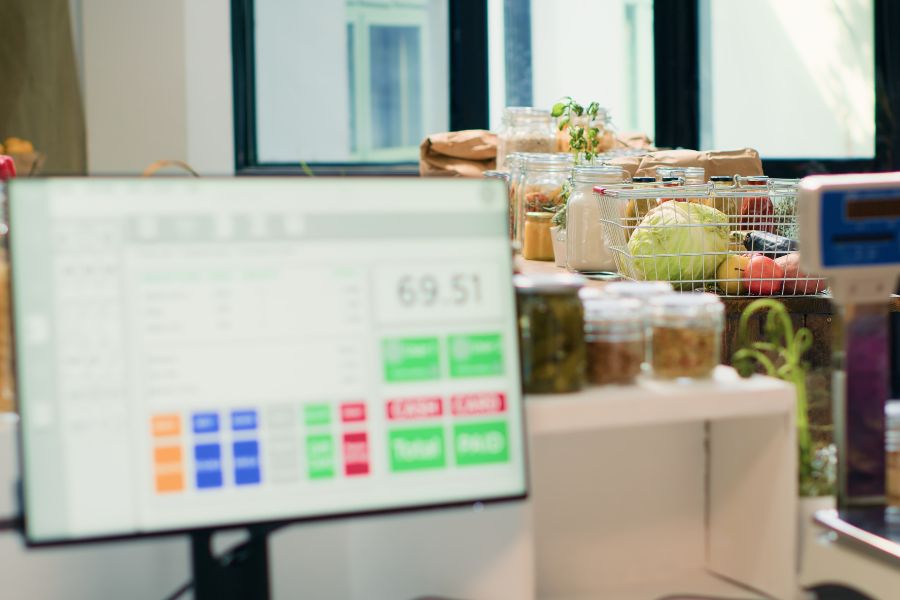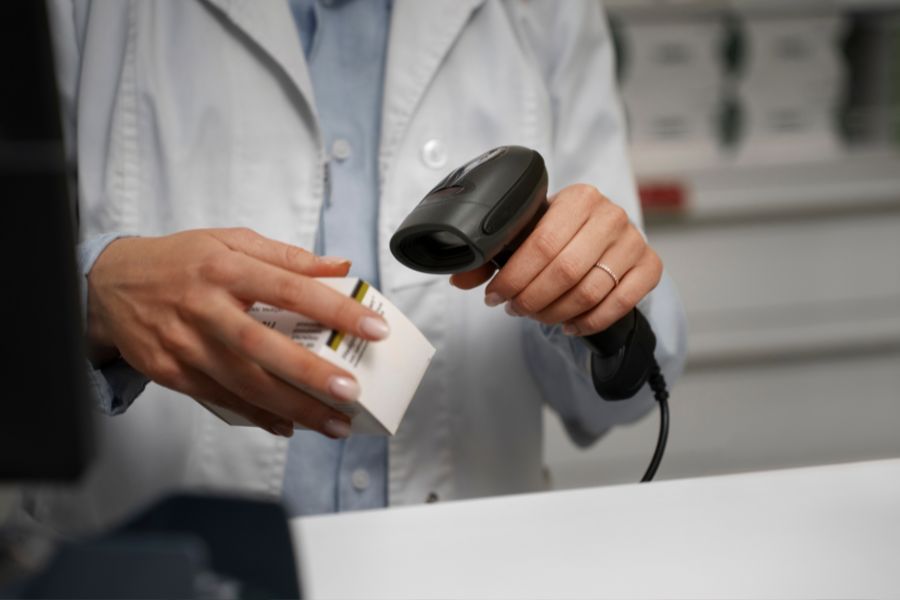An ecommerce POS system is first a digital cash register; but more importantly, it is a multifaceted solution that seamlessly integrates online sales, inventory management, and customer insights. It is the cornerstone of online retail operations and can significantly improve the customer experience while streamlining business processes, making it an indispensable tool for any ecommerce venture intent on scaling and thriving in the digital economy. By leveraging the power of an ecommerce POS system, merchants can unleash unparalleled efficiency and data-driven success. Without a doubt, it is a must-have asset for any online retailer.
Let’s explore the key reasons that make it so vital, and practices to maximize the power of this solution.
What Is An Ecommerce POS System?
The global point of sale (POS) market has witnessed a significant surge in value, climbing from $24.759 billion in 2022 to a projected $58.4 billion by 2028, with a robust compound annual growth rate (CAGR) of 15.38% (Precedence Research). This growth trajectory speaks volumes about businesses’ increasing reliance on advanced POS systems.
At the forefront of this market expansion is the eCommerce POS system, which has become key for retailers looking to manage their online and in-store sales with a single, cohesive system. It streamlines operations by bringing together sales processing, inventory management, and customer engagement in one place, proving to be a game-changer for businesses aiming to enhance their online sales capabilities. As we examine the key features that make eCommerce POS systems indispensable, we’ll understand their critical role in the modern retail landscape.
Key Features of an eCommerce POS System
Choosing the right eCommerce POS system is critical for businesses that seek to excel in the online marketplace. The best systems offer a suite of features designed to optimize retail operations and provide a seamless shopping experience for customers. Here are the key features to look for in an eCommerce POS system:
1. Seamless Inventory Management
Real-time stock updates: Automatically adjust inventory levels with every sale, return, or order.
Product variants and combinations: Manage different sizes, colors, and materials hassle-free.
Stock alerts: Receive notifications when items are low and it’s time to reorder.
2. Multichannel Sales Synchronization
Omnichannel selling: Synchronize online, in-store, and mobile sales to provide a unified shopping experience.
Product information consistency: Ensure product details are uniform across all sales channels.
Order management: Track and process orders from multiple channels in one centralized system.
3. Real-Time Data Analytics and Reporting
Sales trends analysis: Gain insights into which products are selling and at what rate.
Customer behavior tracking: Understand purchasing patterns to tailor marketing efforts.
Financial reporting: Access critical financial data to inform business decisions.
4. Integrated Customer Relationship Management (CRM)
Customer profiles: Store customer information, purchase history, and preferences.
Loyalty programs: Create and manage rewards programs to encourage repeat business.
Targeted marketing: Use customer data to send personalized promotions and communications.
5. Scalability and Flexibility
Modular design: Choose only the features you need now, with the option to add more as your business grows.
Cloud-based access: Manage your business from anywhere with internet access.
Customization: Tailor the system to fit your specific business needs and workflow.
Benefits of Implementing an Ecommerce POS System for Your Business
Implementing an ecommerce POS system brings a multitude of benefits that can transform the way businesses operate and interact with their customers.
1. Expanded Sales Opportunities
The integration of an ecommerce POS system (such as ConnectPOS) serves as a catalyst for expanding sales opportunities. It positions your business to capitalize on the growing trend of omnichannel retailing.
By acting as a digital representative, the POS system allows you to sell in multiple marketplaces, social media platforms, and online stores all at once, providing a consistent presence that meets customers on their preferred platforms.
This expanded reach is complemented by a unified business view that integrates all channels into a single, streamlined system. Not only does this reduce the administrative burden associated with managing multiple sales channels, but it also offers a holistic perspective of your business’s performance, allowing for strategic decision-making that is based on comprehensive data.
2. Enhanced Inventory Visibility
In the fast-paced market, maintaining real-time visibility of inventory is more than just a convenience—it’s a necessity.
An ecommerce POS system gives you an immediate, accurate view of stock levels across all channels, which is essential for effectively managing inventory and avoiding the costly mistake of overselling, especially in scenarios like BOPIS.
This assurance of stock accuracy not only optimizes inventory management but also enhances customer trust, as they can rely on the availability of products they plan to purchase or pick up in-store.
3. Streamlined Data Management
The automation of data handling through a POS system marks a significant leap forward in operational efficiency.
Automatically updating product information and syncing orders eliminates the need for manual data entry, which can often be time-consuming and prone to errors.
The newfound time efficiency that comes with automated data management can be reinvested into other areas of the business that drive growth and innovation, ensuring that resources are allocated towards strategic business objectives rather than tedious administrative tasks.
4. Flexible Promotions and Discounts
The ability to offer promotions and discounts seamlessly across both online and offline channels is a powerful tool for customer engagement.
An ecommerce POS system enables you to run cross-channel marketing initiatives without having to commit exclusively to one channel over another. It allows for a high degree of personalization in your marketing campaigns, as you can customize offers for specific customer segments, enhancing the appeal of your promotions and increasing the likelihood of conversion.
5. Customer Insights for Personalized Engagement
Utilizing an integrated POS system like ConnectPOS to unlock valuable insights into customer behavior. This data is instrumental in refining customer relationship management strategies, as it helps in understanding purchasing patterns and preferences.
With this information, you can personalize customer interactions and tailor your inventory and marketing efforts to meet customer needs better, leading to more informed decision-making and a more targeted approach to driving sales.
6. Elevated Customer Experience
The seamless integration of your POS system with your online store enhances the customer experience. It provides customers with a variety of payment options and a smooth online ordering process, which are critical components of customer satisfaction in the digital age.
Furthermore, by incorporating loyalty programs directly into the POS system, you can foster a sense of loyalty and encourage repeat business. This effectively addresses customer needs in real time and builds a strong, loyal customer base.
Guide to Choose the Right Ecommerce POS System for Your Business
Selecting the right ecommerce POS system for your business is a critical decision that can have a significant impact on your operations and customer experience.
Step 1. Define Your Business Needs
Before diving into the sea of available POS options, take a step back and evaluate what your business actually needs.
Consider:
The size of your business, the volume of transactions, the diversity of your inventory, and the channels through which you sell.
Are you a small boutique with a single location, or a growing business with multiple outlets and an online store?
Do you require advanced inventory management features, customer relationship management (CRM) tools, or support for loyalty programs?
It’s also important to think about the future and choose a system that can scale with your business. Look for flexibility and features that will support your growth, such as the ability to add new sales channels, manage increasing transaction volumes, or expand product lines without significant system changes.
Step 2. Comparing Different eCommerce POS Systems
With a clear understanding of your needs, you can begin to compare the different eCommerce POS systems on the market. Focus on the features that are most important to your business. Some systems may offer strong inventory management capabilities, while others might excel in customer engagement or analytics.
Read reviews, case studies, and customer testimonials to understand each system’s strengths and weaknesses. Pay attention to comments about the system’s ease of use, reliability, and customer support, as these factors will affect your day-to-day operations.
Step 3. Considering Integration with Other Tools and Platforms
Your POS system should not be an island unto itself; it needs to integrate smoothly with other tools and platforms you use, such as accounting software, eCommerce platforms, email marketing services, or inventory management systems. Seamless integration reduces the need for manual data entry and helps ensure that all parts of your business communicate effectively.
Check whether the POS systems you are considering have built-in integrations or if they offer APIs for custom integrations. It’s crucial that any system you choose can work harmoniously with your existing tech stack or any future tools you plan to implement.
Step 4. Evaluating Cost and ROI
Finally, consider the cost of implementing and maintaining each eCommerce POS system. This includes not only the upfront costs or monthly subscription fees but also any additional expenses for hardware, add-ons, or transaction fees. Make sure you understand the total cost of ownership for each system you’re considering.
Balance the cost against the potential return on investment (ROI). A more expensive system might offer features that could boost sales, improve customer retention, or save time on administrative tasks, ultimately justifying the higher price tag.
By carefully evaluating your needs, comparing options, considering integration capabilities, and weighing costs against potential ROI, you can select the right eCommerce POS system that aligns with your business goals and sets you up for long-term success.
Integrating Your POS and Ecommerce Site In 8 Steps
Integrating your POS system with your ecommerce site is a strategic move that streamlines your operations, synchronizes sales channels, and provides a unified customer experience.:
Step 1: Establish Clear Integration Objectives
Start by setting clear goals for what you want to achieve with the integration. This could include real-time inventory updates, unified sales reporting, or a seamless checkout experience for customers.
Having a clear set of objectives will guide the integration process and help you measure its success.
Step 2: Inventory Your Tech Stack
Take inventory of your current technology stack.
Understand the capabilities of your eCommerce platform and POS system, and ensure they are compatible or can be made compatible through integration. This may involve checking for available APIs, plugins, or third-party integrators that facilitate the connection between systems.
Step 3: Choose the Right Integration Tools
Based on your tech stack inventory, choose the right tools and solutions for the integration.
This might involve using built-in integration modules provided by your POS or ecommerce platform, or employing middleware that can bridge the two systems. Ensure the tools you select can handle the data throughput and complexity of your operations.
Step 4: Map Data Flows and Processes
Before you begin the technical work, map out how data will flow between your POS and ecommerce systems.
Decide which system will be the master for different types of data (e.g., inventory, product information, customer data) and how conflicts will be resolved. This is crucial for maintaining data integrity and consistency across platforms.
Step 5: Execute a Pilot Integration
Conduct a pilot integration with a limited dataset or in a controlled environment. This allows you to troubleshoot issues and refine data mapping in a low-risk setting.
Monitor the integration closely, check for data accuracy, and ensure that all systems are communicating as expected.
Step 6: Train Your Team
Prepare your team for the change in processes that will come with the integration.
Provide training on the new system workflows, focusing on how to handle discrepancies, customer inquiries, and daily operations. The more knowledgeable your team is, the smoother the transition will be.
Step 7: Go Live and Monitor
After thorough testing and team training, go live with the integration. Monitor the system closely during the initial period following the launch.
Be prepared to address any unexpected challenges and make adjustments as needed.
Step 8: Gather Feedback and Optimize
Post-integration, gather feedback from customers and staff to identify any pain points or areas for improvement. Use this feedback to optimize the integrated system.
Regularly review your integration objectives and performance metrics to ensure the integration continues to meet your business needs.
By following these steps, you can effectively integrate your POS and ecommerce site, enabling a more efficient, data-driven, and customer-centric business operation.
Common Challenges and Solutions in Ecommerce POS System Implementation
Implementing a new eCommerce POS system can be a complex process. Here are some common challenges and solutions to ensure a smooth implementation:
Integration Hurdles
Challenge: Integrating your POS with other business systems can be technically challenging, especially if they use different data formats or protocols.
Solution: Prioritize POS systems with robust APIs and extensive integration capabilities. Engage with technical experts or integration specialists who can navigate complex system connections. Ensure thorough testing is conducted during the pilot phase to iron out any issues.
Training and Adoption Among Staff
Challenge: Resistance to change and a lack of technical skills can hinder the adoption of a new POS system among staff.
Solution: Implement comprehensive training programs that cater to employees at different skill levels. Use a combination of hands-on, visual, and written training materials. Encourage a culture of open communication where staff can express concerns and ask questions.
Ensuring Technical Support and Customer Service
Challenge: Technical glitches can occur post-implementation, and inadequate support can disrupt business operations.
Solution: Choose a POS provider known for reliable customer service, such as ConnectPOS. Establish a clear support protocol within your business, and ensure staff know who to contact for help. Consider a service level agreement (SLA) with your provider for guaranteed response times.
Best Practices for Maximizing Your Ecommerce POS System’s Performance
To get the most out of your ecommerce POS system, consider the following best practices:
Regularly Updating and Upgrading Your System
Staying current with software updates is critical for security and functionality. Schedule regular check-ins to apply updates and consider upgrades that can enhance system capabilities and support business growth.
Utilizing POS Data for Strategic Planning
Your POS system is a goldmine of data. Use insights from sales trends, inventory levels, and customer preferences to inform business decisions. Analyzing this data can help refine your marketing strategies, inventory management, and overall business planning.
Embracing Omnichannel Strategies
A POS system that integrates with multiple sales channels enables a seamless customer experience. Leverage this capability to provide consistent service whether customers are shopping online, in-store, or through social media platforms.
Fostering Continuous Feedback and Improvement
Regular feedback from both customers and staff is invaluable. Use this feedback to continually assess and improve your POS system’s performance. Stay adaptable and be willing to make changes to your processes and technology as your business evolves.
By addressing common challenges head-on and adhering to best practices, you can ensure that your eCommerce POS system implementation is successful and that your system continues to support your business effectively over time.
ConnectPOS is the definitive POS solution for retailers looking to unify their online and brick-and-mortar sales. This system offers real-time synchronization between channels, ensuring inventory and sales data are always accurate and up to date.
With its intuitive design and robust functionality, ConnectPOS is engineered to meet the demands of modern retail seamlessly. From in-depth analytics to comprehensive omnichannel support, this platform is built to streamline your operations and engineered to grow with your enterprise. By choosing ConnectPOS, you are securing a powerful ally in retail management, one that confidently stands as the right system to propel your business forward.
Takeaway Notes
A well-designed ecommerce point-of-sale (POS) system is essential for retailers to thrive in an environment where digital and physical sales are merging. Choosing a system that aligns with your business goals and is fully integrated can lead to better operational efficiency, insightful data analysis, and improved customer interactions. The challenges of implementing a new system, training staff, and providing ongoing support can be formidable but can be managed with a well-thought-out strategy.
In a bigger picture, a powerful ecommerce POS system goes beyond being just an operational tool and becomes a valuable asset for business growth and adaptability. Retailers who are committed to investing in these sophisticated systems and adopting industry best practices are positioning themselves for success, ready to handle current and future market demands, and able to provide unmatched service that cements their position in the market.
If you wish to further explore ConnectPOS’s power in boosting your ecommerce business, or require any information, don’t hesitate to contact us!



